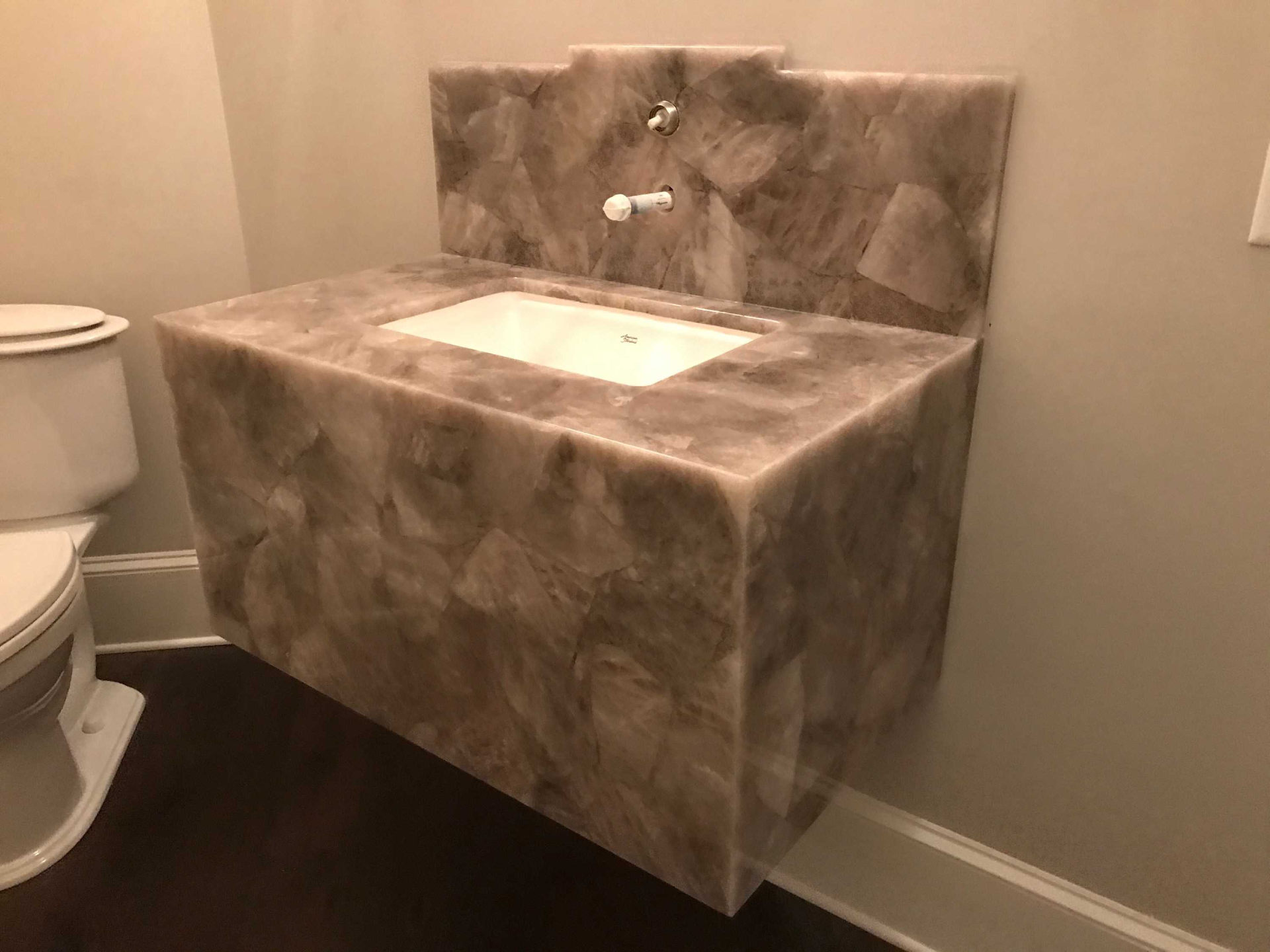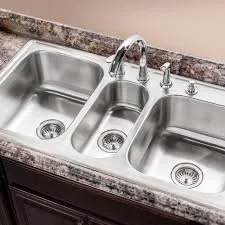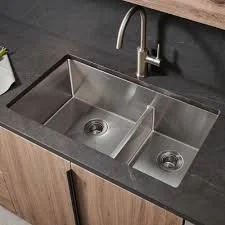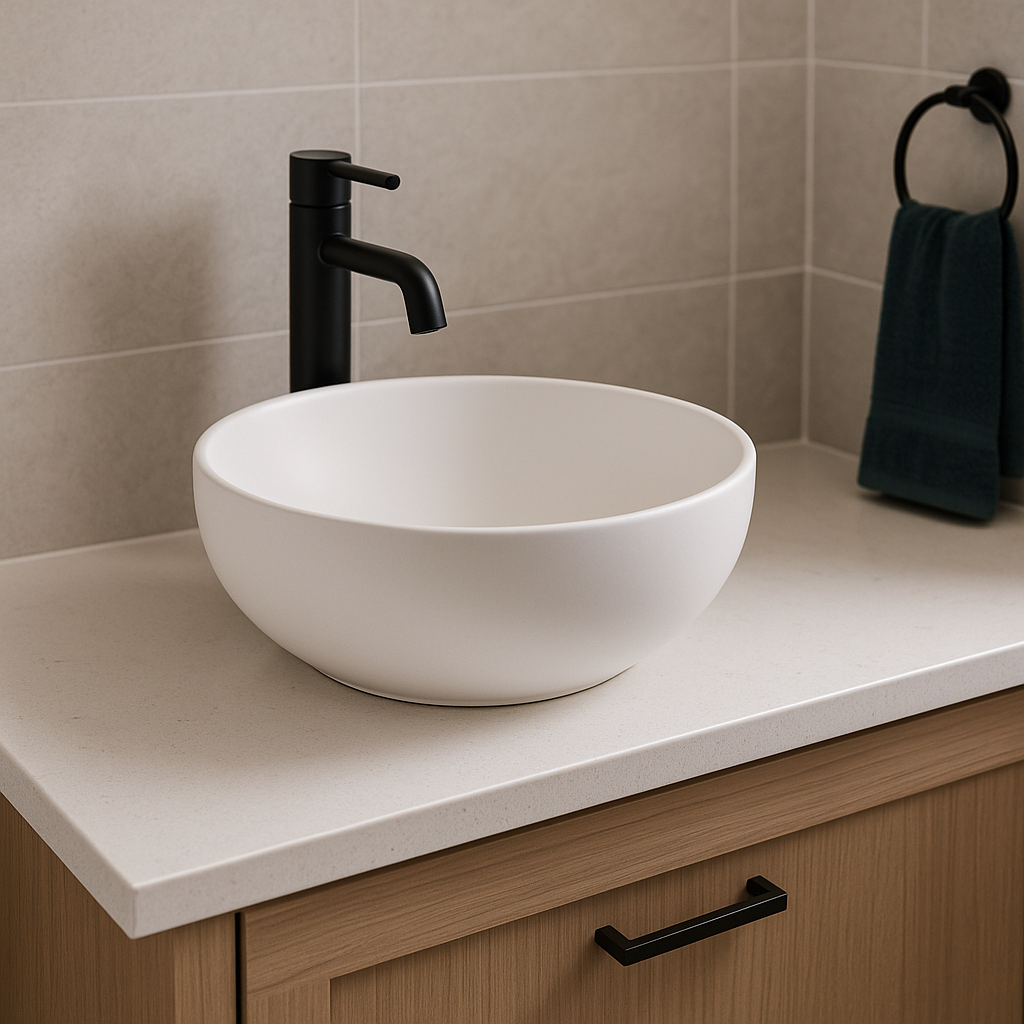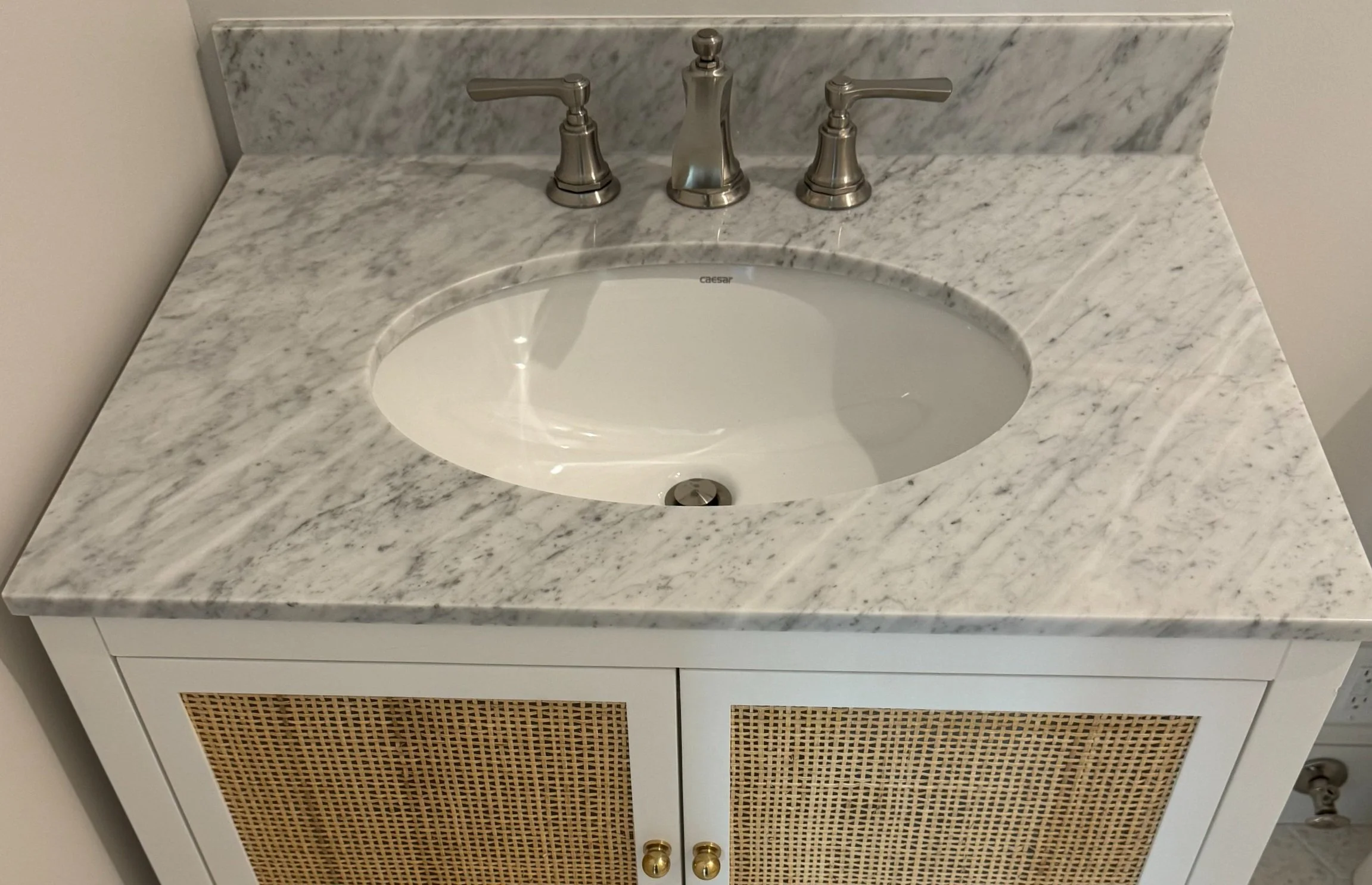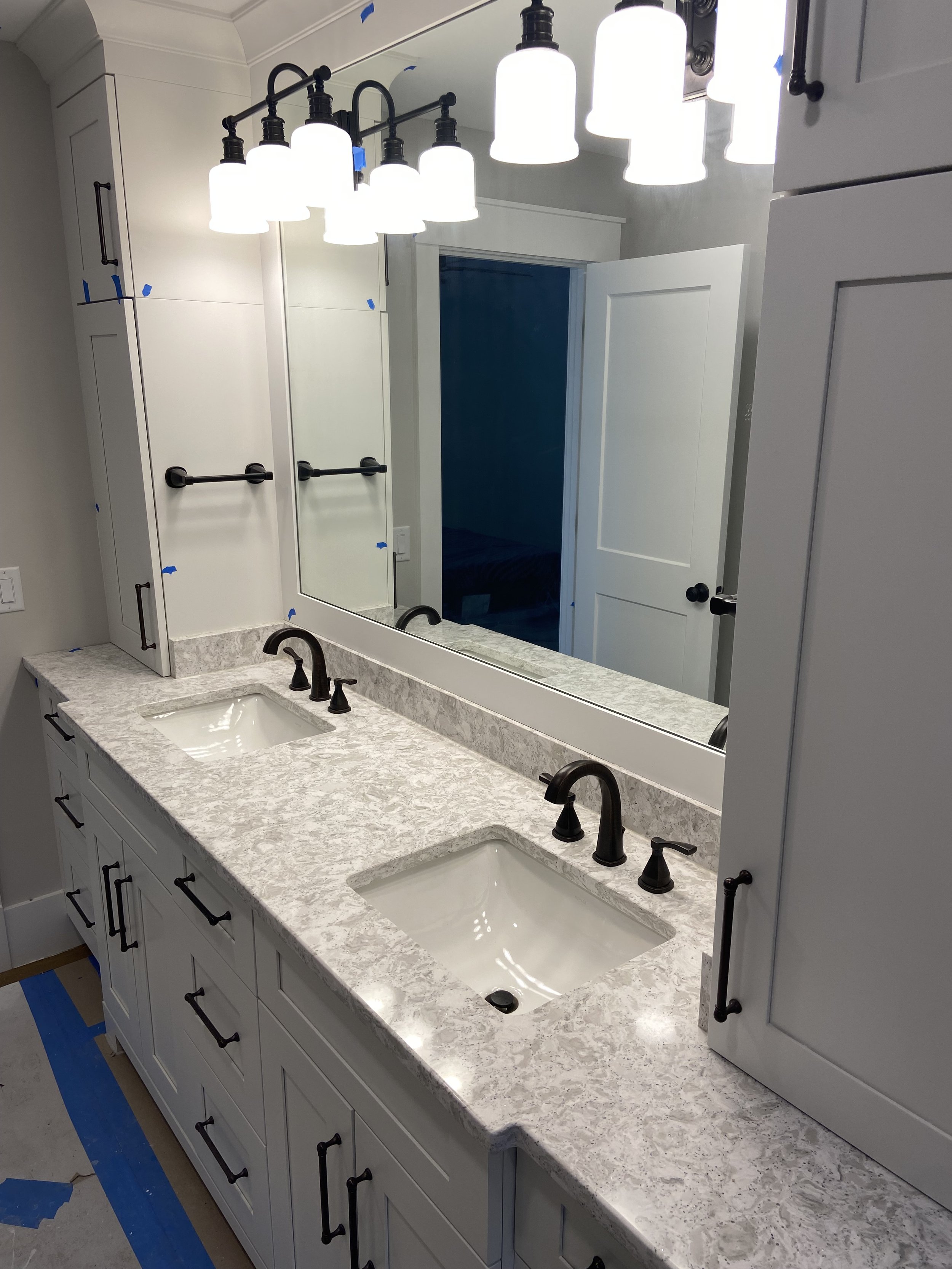
Kitchen & Bathroom Sink Types: A Comprehensive Guide
Your choice of sink has a major impact on both the look and function of your kitchen or bathroom. From installation style to bowl configuration to material, today’s market offers far more variety than the simple drop-in stainless basin of the past. In this detailed guide, we’ll explore every major sink type—diving into how they’re installed, what they’re made of, and the pros and cons of each option—so you can select the perfect sink for your space and lifestyle.
Kitchen Sink Types
1. Installation Styles
Drop-In (Top-Mount) Sinks
Description: The sink’s rim rests on the counter cut-out.
Pros: Easiest to install or replace; rim hides uneven cut-outs.
Cons: Lip can trap crumbs; less sleek appearance.
Ideal For: DIY kitchen updates; budget-minded projects.
Ready to update your kitchen, bathroom or powder room?
5. Wall-Mounted & Hanging Sinks
Description: Mounted directly to wall studs—no base cabinet underneath.
Pros: Frees up floor space; easy clean-up; industrial look.
Cons: Limited sizes and styles; installation requires strong wall backing.
Ideal For: Small kitchens, utility rooms, or commercial-inspired spaces.
2. Undermount Sinks
Description: Clamped beneath the countertop for a seamless edge.
Pros: Easy wipe-down from counter to sink; modern look.
Cons: Requires solid-surface countertops (granite, quartz); more complex install.
Ideal For: Contemporary kitchens; heavy cooking households.
3. Farmhouse (Apron-Front) Sinks
Description: Exposed front face that extends past cabinet edge.
Pros: Striking focal point; deep basin; ergonomically close to user.
Cons: Requires custom cabinetry; heavy (especially fireclay).
Ideal For: Rustic, farmhouse, or transitional designs.
4. Integrated Sinks
Description: Molded from the same material as countertop (e.g., solid surface or quartz).
Pros: Completely seamless; no crevices for grime.
Cons: Often higher cost; repair requires matching material.
Ideal For: Ultra-clean, minimalist aesthetics.
2. Bowl Configurations
Single Bowl
Generous uninterrupted space—perfect for oversized pots and pans.
Double Bowl
Equal-sized bowls—versatile two zones for washing and rinsing.
Offset bowls—large left basin with smaller right side for prep.
Triple Bowl
Incorporates a third mini-basin (ideal for draining or prep accessories).
Corner & Prep Sinks
Installed in a corner or secondary countertop—ideal for workstations and second prep areas.
Single
Triple
Double
Prep Sink
3. Material Options
Stainless Steel
Pros: Economical; durable; virtually stain-proof; matches appliances.
Cons: Prone to scratches and water spots; noise unless sound-deadening pads used.
Fireclay
Pros: Traditional look; naturally resistant to scratches, chips, and high heat.
Cons: Limited colors; heavy; higher price point.
Quartz Composite
Pros: Extremely hard; uniform color; hygienic non-porous surface.
Cons: More expensive; heat resistance varies by brand.
Concrete
Pros: Custom shapes/colors; industrial-chic appeal.
Cons: Must be sealed regularly; can crack if overloaded.
Cast Iron with Porcelain Enamel
Pros: Classic glossy finish; extremely durable when enamel intact.
Cons: Heavy; enamel can chip if struck.
Granite Composite (Granite + Resin)
Pros: Durable; non-porous; resists stains, scratches, heat; matte, “stone-like” finish.
Cons: Can be noisy; limited to darker, earthy tones.
Copper & Bronze
Pros: Natural antimicrobial properties; warm patina develops over time.
Cons: Requires regular polishing; can dent or scratch.
Solid Surface (e.g., Corian®)
Pros: Seamless integration; easy to repair scratches or stains.
Cons: Lower heat resistance; more prone to scratching.
II. Bathroom Sink Types
1. Installation Styles
Undermount Sinks
Sleek, easy-clean edge; popular in modern baths.
Drop-In (Top-Mount) Sinks
Easiest to install and replace; wide lip rests on vanity top.
Vessel Sinks
Bowl “sits” on top of the counter; available in glass, stone, and ceramic.
Pedestal Sinks
Basin on a freestanding pedestal; ideal for half baths or small spaces.
Console Sinks
Basin supported by decorative legs or a shelf; blends open feel with storage.
Wall-Mounted Sinks
Basin affixed to the wall—no cabinet or pedestal; maximizes floor space.
Integrated Countertop & Sink
One-piece surface (solid surface, stone) for a monolithic look.
Vessel Sinks
2. Basin Shapes & Sizes
Round & Oval: Soft, elegant lines; vessel styles often use these shapes.
Rectangular & Square: Clean, contemporary feel; provides more usable rim space.
Corner Basins: Compact solution for tight powder rooms.
Round & Oval
Rectangular & Square
Corner Basins
3. Materials
Ceramic / Porcelain
Pros: Classic white finish; easy to clean; budget-friendly.
Cons: Can chip if heavy objects strike.
Glass (Tempered)
Pros: Striking visual appeal; wide range of colors/finishes.
Cons: Shows water spots; delicate—must clean regularly.
Stone & Marble
Pros: Luxurious natural veining; unique patterns.
Cons: Porous—requires sealing; heavier and costlier.
Stainless Steel
Pros: Sleek, hygienic; matches kitchen hardware.
Cons: More utilitarian look; can scratch.
Fireclay
Pros: Chip-resistant; high-gloss finish; farmhouse style.
Cons: Limited color palette; heavyweight.
Solid Surface
Pros: Seamless install; easy repair of scratches.
Cons: Lower heat resistance; scratches more easily.
III. Choosing the Right Sink for Your Space
Assess Your Workflow
Do you prep and wash in the same sink? A large single-bowl undermount offers maximum flexibility for pots and pans.
Prefer separate prep? Add a small prep or bar sink in a corner or island.
Match Your Style
Rustic/Farmhouse: Fireclay apron-front or granite composite in muted tones.
Modern/Minimalist: Integrated solid-surface or undermount stainless steel.
Transitional: Polished stone composite with clean lines—balances warmth and sleekness.
Factor in Maintenance
Low-maintenance priority? Choose non-porous materials (quartz composite, stainless steel, porcelain).
Don’t mind periodic care? Porous natural stone or fireclay can reward you with timeless beauty.
Consider Your Countertop
Undermount sinks require sturdy, non-porous counters (granite, quartz).
Drop-in sinks work on almost any material, including laminate.
IV. Installation & Maintenance Tips
Professional vs. DIY: Undermount and farmhouse sinks often need pros; drop-ins can be DIY-friendly.
Sealing: Stone and fireclay require sealing every 1–2 years to protect against stains and chips.
Sound-Dampening: Stainless steel sinks benefit from under-mount rubber pads or foam to reduce noise.
Prevent Scratches & Chips: Use rubber mats or silicone grids in composite and fireclay basins.
Avoid Extreme Heat: Even “heat-safe” materials can discolor—always use trivets under hot cookware.
V. Bringing It All Together
Selecting the ideal sink means balancing aesthetics, functionality, and maintenance. By understanding the installation styles, bowl configurations, and materials available for both kitchens and bathrooms, you can tailor your choice to match your design vision and daily routines.
Next Steps:
Review your floor plan and countertop material.
Narrow down by installation style and preferred bowl layout.
Decide on a material that aligns with your maintenance comfort level.
Contact a certified installer to confirm measurements and support requirements.
With this guide in hand, you’re well on your way to choosing a sink that not only looks beautiful but performs flawlessly for years to come.




